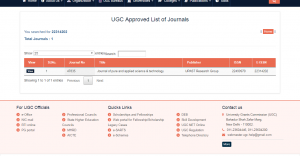Studies of Glycine Dimethyl Urea Crystals Grown by Aqueous Solution Method
U. Rajesh Kannan1,*, G. Narayanasamy2, S. Subramanian3 and P. Selvarajan4
1,*Research Scholar, Reg. no. 12116, Department of Physics, M.D.T. Hindu College, Tirunelveli, Tamilnadu, India. *Corresponding author: rajeshphymsu@gmail.com
2Asso. Prof., Department of Physics, Kamaraj College, Tuticorin, Tamilnadu, India.
3Prof & Principal (Rtd.), Department of Physics, M.D.T. Hindu College, Tirunelveli, Tamilnadu, India.
4Asso. Prof., Department of Physics, Aditanar College of Arts and Science, Tiruchendur, Tamilnadu, India.
(Manonmaniam Sundaranar University, Abishekapatti, Tirunelveli, Tamilnadu, India)
Glycine dimethyl urea single crystals were grown by aqueous solution method with slow evaporation technique. Let this crystal be called as GDMU crystal. The grown crystals were characterized chemically, structurally, thermally, optically and mechanically by various studies. X-ray diffraction (XRD) analysis indicates the crystal system as monoclinic. The functional groups have been identified using Fourier transform infrared (FTIR) and FT-Raman spectral analyses. Optical transmittance studies reveal very low absorption in the entire visible region. The thermal stability of the title crystal was found by the TG/DSC analysis. Mechanical characterization was done by studying the variation of microhardness with applied load. Solubility of the material was gravimetrically analyzed. The impedance analysis was performed for the sample to understand the electrical properties. Z-scan technique was employed to confirm the third order nonlinearity of the grown crystals. Its relative SHG efficiency has been tested by Kurtz powder method and it shows 1.145 times that of potassium dihydrogen phosphate (KDP). The elements present in the sample were identified by EDAX method. Photoluminescence studies were carried out for GDMU crystal to identify the photo emission peaks and the results from the various studied were analyzed.
Keywords: Aqueous Solution method, XRD, FTIR, FT-Raman, TG/DSC analysis, Hardness, Impedance, Z-Scan Spectroscopy, Second Harmonic Generation (SHG) efficiency, EDAX, Photoluminescence.






